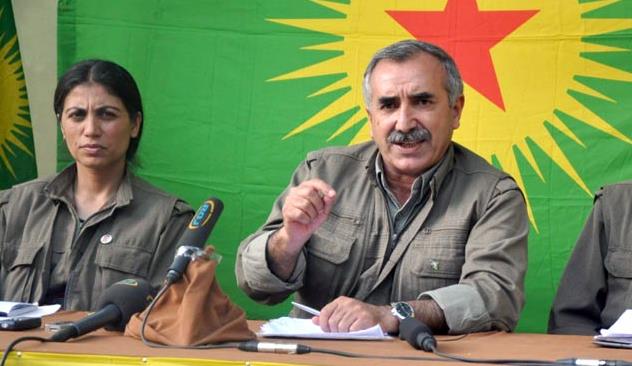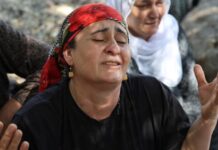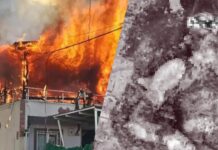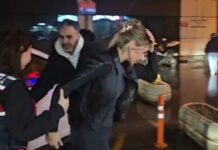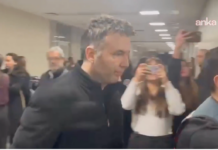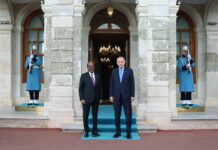Halil Berktay
The Turkish original of this article was published as Bakur-Rojava yolunda (2) PKK savaş kararını nasıl aldı? on 28th December 2015.
[December 27-28, 2015] Where am I? I had embarked upon outlining the PKK’s and HDP’s zigzags between war and peace, and between an in-Turkey solution and a solution outside Turkey. In the first part of this article (published in Turkish on 13th December 2015, and in English on 3rd January 2016), I brought the story down to 2011. I stressed four main points: (1) Fundamentally, what is involved is a certain inability to do without violence. Growing old and mentally rigid over years of war, the Kandil leadership has come to see the Kurds, together with all their demand for equality and freedom, not as its end-all and be-all, but as its subjects and an instrument for its own power. It’s been quite some time since they arrived at this point, but it has only fully surfaced with their armed urban occupations, so that many people are coming to see it for the first time. (2) The 2002, 2007 and 2011 elections have caused the PKK to develop a certain fear of the AKP. This in turn has led them to turn their backs on Turkey’s overall democratization process. That is why the PKK first started to treat the AKP as an enemy. It began to see the AKP not as its interlocutor, perhaps even its partner in a peaceful solution process, but as the greatest threat to its regional hegemony. Long before 2014, this was the first flowering of a policy which would eventually crystallize in the “we are not going to allow you to become president” slogan. (3) Also along the same lines, the PKK never really relinquished its original aim of separating from Turkey and establishing its own state. For this the first step was to establish an absolute local hegemony over a certain territory. And this could be achieved only through guns and violence. To put it the other way round, the PKK’s total refusal to lay down its arms implied that, while it seemed to have abandoned its aim of separating from Turkey and was putting on an appearance of having reconciled itself to an “in-Turkey” solution, deep inside it was holding on to project of establishing its own state, which alone could provide the only rationale for maintaining the armed struggle. (4) And indeed, in 2010-2011 too, the PKK looked for every opportunity to flee from peace, and eventually seized on the High Electoral Board’s annulment of Hatip Dicle’s election — on the grounds of a 20-month prison sentence for PKK propaganda – to make its “last exit before the bridge.” It was on this pretext that the BDP’s “independent” MPs boycotted parliament, which in turn was followed by the PKK’s Silvan ambush. So the guns took over yet again, and this period of bloodshed then continued until Öcalan’s 2013 Newroz call.
When I review this whole process (occasionally with the help of extensive quotations from the articles that I wrote at the time), I am struck by the following: There are striking resemblances between what happened in 2010-2011 and then again in 2014-2015. The PKK+BDP’s methods and tactics of four years ago and the PKK+HDP’s methods and tactics today are almost exactly the same. The hopes then pinned on the “BDP bloc” (without any “adherence to peaceful politics” condition) have also been echoed by the hopes pinned on Demirtaş and the HDP (purely for the sake of hostility to the AKP, and without a thought for the PKK lurking backstage). There is, however, one major difference, maybe two: This time around, the PKK believes that Syria’s dissolution and the internationalization of the Syrian crisis provides it with a historical opportunity that may never be found again. Hence it is, that it has completely abandoned any vision of an in-Turkey solution, instead orienting itself much more emphatically towards a “Bakur-Rojava” (north-south) state formation project. The HDP has also been persuaded to this plan as never before, brought into line, bullied into obedience, and forced to burn all its bridges by adopting a language of violence that has put paid to all democratic possibilities once and for all.
But so, how did we get from the last de facto ceasefire that started in 2012/13 to the present state of affairs? Recent information makes certain things much clearer. For example, just as I had surmised, (5) even back in 2012 there was a decision and a plan for eventually going back to war. It was only kept secret as part of the PKK’s immense hypocrisy and dishonesty, but it was always there. Indeed, we now learn that it was only with great reluctance that the PKK leadership accepted (or pretended to accept) Öcalan’s effort to force them a de facto ceasefire and an in-Turkey democratic autonomy solution. Now Murat Karayılan has told the whole story in explicit and rather brazen fashion: “At the time, we were caught in the middle. We couldn’t come out into the open to say: ‘We have a war plan, we have made all our preparations, we want to carry on with the war.’ This was our basic mistake. (…) So what we did was to convey in an appropriate language that we were not very enthusiastic about going ahead with the [peace] process. What we really wanted was to fight. But we had to cancel our war plans. After the snow melted we went and withdrew our stocks of ammunition and heavy weapons from those areas. (…) Had it not been for those efforts of the Leadership, already in 2012 Turkey would have entered a period of major fighting, and the election processes of the last two years would have been out of question’ (ANF [Euphrates News Agency] interview, 17th June 2015). This is an enormous confession in itself. By itself it is enough to prove, first, that Kandil always intended to fight. That is why it implemented neither “laying down its arms” nor “leaving Turkey” — although it pretended to agree to both. On the contrary, ever since 2012, it was always searching for new pretexts to get out of the no-conflict situation. It was even looking forward to a conflict that would spread all over Turkey to the point of making elections impossible to hold (which also sheds some light on what it hopes to achieve now). In the same breath, it also becomes clear that for Murat Karayılan or the PKK the word “peace” is a matter of utter Machiavellian pragmatism, to be utilized as coldly and callously as Duran Kalkan’s face.
(6) Eventually, the opportunity the PKK was looking for showed up not as a single incident, but in the form of a chain of five big events. (a) The Gezi demonstrations and December 17-25 “anti-corruption operations” of 2013; (b) the deepening of the Syrian crisis; (c) the rise of ISIS; (d) the Kobani resistance; and (e) the 7th June 2015 elections were interpreted by Kandil’s hawks as so many indications that the time to act had come.
(6a) The Gezi demonstrations rocked the AKP, gave rise to a discourse of “dictatorship,” and raised the PKK’s (as well as others’) hopes by creating the impression that the government might not be as strong as it looked. The earthquake then gathered force with the December 17-25 “anti-corruption operations,” generally blamed on the Gülen Movement’s minions within the police and the judiciary, but behind which are likely to have been other and much bigger players, especially with regard to strategic decision-making and getting the very long-term planning in motion. In any case, they momentarily caused hopes of the AKP’s “imminent collapse” to reach a rapid peak. Kandil, too, came out of it with a reinforced belief that it would now be facing an Erdoğan leadership that was very weak and fragile.
(6b) Syria fell apart, leaving almost no semblance of central authority. Virtually all ethno-religious groups and armed opposition organizations began to set up their own territories. In the process, a possibility of autonomy also arose for the Kurdish region of “Rojava” extending along Syria’s northern border with Turkey. As the PKK’s Syrian extension or subsidiary, it was the PYD that benefited. It used its armed force to initiate nothing less that an ethnic cleansing, expelling the non-Kurdish population as well as all Kurds that it regarded as not belonging to its own mass base. It thereby established its hegemony over most of the region, where it set up a series of cantonal administrations. This led to PKK leadership to believe that “we already have a territory of our own at Rojava.”
(6c) Syria’s fall also gave rise to the IS monster. As the Sunni opposition to Assad found itself squeezed between the régime’s incessant attacks and the weakening of Western support, it became increasingly radicalized, with its most ferociously fanatical elements re-forming themselves as ISIS or IS. Like so many other examples in history (including the PKK), IS then started to attack everyone around it in order to eliminate its rivals through violence, seize territory for itself, and try to establish its own state. This transformed all previous power relations in Syria and led to a new alignment. In this context, especially the US began to regard all potentially anti-IS forces — including the Kurds, the PYD, and therefore also the PKK — as potential allies and therefore with growing sympathy.
(6d) This tendency climaxed with the Kobani resistance. On 13th September 2014 the IS launched an offensive against PYD villages in the Kobani countryside. By 2nd December it had established its control over approximately 350 villages, and strongly penetrated the town center itself. The danger of Kobani falling into IS hands then called forth a broad alliance. After some fierce fighting, helped by Allied aerial bombardment, IS had to pull out of the town center on 26th January 2015, and it had fallen back on new defensive lines 25 kilometers away by 2nd February. This siege and resistance had a huge impact on the PKK’s prestige. The PYD and therefore the PKK were now cast in the front ranks of the struggle against IS. For Kurdish nationalism, Kobani provided a new focus. There emerged a legend compared by some commentators to the World War II battle of Stalingrad. Around 8000 Kurdish young men from southeast Turkey may have gone to fight at Kobani, together with many ultra-left MLKP [Marxist-Leninist Communist Party] or DHKP-C [People’s Revolutionary Liberation Party and Front] militants who latched on to what they regarded as the contemporary counterpart of the Spanish and Greek civil wars of the 1930s and 1940s. (Most of them appear to have returned, and are now said to be participating in the PKK’s armed town occupations in the southeast.)
Turkey, on the other hand, failed to stand up for the Kurds during the Kobani siege and resistance, losing a lot of prestige and credibility. The AKP government did maintain free passage back and forth between Kobani and Turkey. It also provided financial assistance, and allowed more than 200,000 Kobani Kurds to seek refuge in Turkey. At the same time, its huge deployment always remained on the Turkish side of the border, and did not so much as open artillery fire against the IS advance. At the time, I wrote two articles with rather emphatic titles: Türkiye bu savaşa girmek ve Kobane’yi kurtarmak zorunda [Turkey has to join this battle and save Kobani; October 3-4, 2014] and Zaman geçer, fırsat kaçar, Kobani’ye dönemezsin [Time passes, opportunities vanish, you cannot go back to Kobani; 10th July 2015]. Some of my friends were very critical, arguing that entering a war beyond our borders was nothing but an adventure which Turkey should absolutely avoid in order not to be dragged into the Middle Eastern bog. They were wrong and I was right — and I believe that I have been proven completely right. Thus to begin with, the idea of not getting involved in the Syrian crisis and not having to join the war against IS was nothing but an illusion, a dream. Recently, Gürbüz Özaltınlı has come up with a profound and eloquent critique of the ideological roots and origins of this dream (see footnote 1). In practice, indeed, ultimately Turkey did join the Western coalition and began to fight against IS. And it had to, for second, each and every policy should be assessed for what it costs as well as what it pays. To put it more clearly, every policy has a price, including “passivity, caution, holding back, and not getting involved,” and sometimes this price can be much higher than the cost of taking some simple steps, all too hastily labeled as an “adventure” — such as advancing two columns of tanks no more than five kilometers inside Syria on both sides of Kobani.
This, indeed, is what happened; Turkey has paid and is still paying a very heavy price for having been so slow for months over Kobani. It was during this period that, together with deliberate misinterpretations of an unfortunately ambiguous statement by President Erdoğan, Turkey began to be seen as standing by on purpose in order to allow IS to decimate the Kurds. It was also during this period that the AKP came to be identified with IS. Some MIT [National Intelligence Organization] trucks that were intercepted while officially taking humane relief to the Turks (Turcomans) of north Syria were alleged to have been supplying IS with heavy weapons and ammunition; this fiction was spliced onto the all too real mistakes over Kobani — and the resulting disinformation campaign made a huge impact on the Western media, so that certain sections of the West started to see Turkey further away and the PKK-PYD much closer to themselves. The PKK leadership put this down as yet another big plus for itself, concluding that its historic window of opportunity was growing bigger by the moment.
(6e) On top of everything there came the 7th June 2015 elections. Those sections of the Turkish public, including the mainstream media, that till then had kept their distance vis-à-vis the Kurdish nationalist movement, took a drastic u-turn to pin their hopes of bringing the AKP down on the HDP, which under the Selahattin Demirtaş leadership was basing its own election campaign on a very strong hostility to especially President Erdoğan. Virtually all arguments we have cited above, from the Gezi and December 17-25 “evidence” of a “dictatorship” to working hand in glove with IS, were marshaled against the AKP and in support of Demirtaş, hurting the AKP to the point where its vote fell to 41percent, causing it to lose its absolute majority in parliament, while the HDP took 80 seats — by far the biggest victory ever by any “legal wing” of the Kurdish movement. Indeed, the PKK may not have liked the possibility of the HDP thereby becoming more autonomous. But clearly, its primary reaction was to see the AKP as even weaker and itself as even stronger than before, especially since it was prone to regarding the votes cast for the HDP as a popular support for itself which would henceforth always be there regardless of what it might say or do.
(7) In brief, this is why and how, in July 2015, the PKK decided to go back to war. Please, at least at this point let us refrain from lying in each other’s face. It was not Erdoğan who first rejected and overthrew the Dolmabahçe agreement. Demirtaş and the Kandil leadership, intuiting that this accord might tie their hands, reacted very quickly and became the first to object. It was only subsequently that Erdoğan, too, reacted against them. Even so, disavowing the Dolmabahçe accord could not by itself constitute an excuse for ending the de facto ceasefire.
Neither will it do, at this point, to argue that it was Erdoğan who started the war “ in order to win the new elections.” For it was the PKK who deliberately re-started the war in cold blood. In fact, for the general public it did come a bit out of the blue. But not for the PKK. Murat Karayılan’s ANF interview of 17th June, which I have already quoted, is very clear on this point. They were looking for a way of getting out of the last cease-fire which they had accepted unwillingly because they couldn’t say no to Öcalan, and they thought they had found all the excuses they needed in Syria, in Kobani, and in the outcome of the 7th June elections. Taking advantage of the AKP’s “weakness” and “isolation,” they came up with a new dream of state-building on a stretch of land comprising all the Kurdish regions of Bakur and Rojava along the north and south of the Syrian border. Or perhaps they revived and reanimated an already existing dream that was only lying dormant.
In any case, let us recall what then happened. The Turkish state had not yet engaged in any fighting when the KCK first issued a statement to the effect that they “would not allow any new dams, roads or construction, and would henceforth intervene to halt all such activities” in the Kurdish region, i.e. in what they considered to be their own territory. It followed up on that declaration by immediately starting to set up roadblocks, intercept traffic, carry out identity checks, attack construction sites, and set fire to trucks and building machinery. Next, KCK co-chair (Ms) Bese Hozat wrote a by now famous (or notorious) article on “the new people’s revolutionary war,” arguing that civilian politics had turned out to be (and was always going to be) inadequate, and that it had not been (and was not going to be) able to fully utilize the existing potential and historic opportunity. What she meant was precisely this “Kurdestan” project extraneous to Turkey for pursuing which the HDP’s 80 deputies in parliament were not likely to be of much use. She was followed by the other KCK co-chair ((Mr) Cemil Bayık’s call to “prepare for self-defense,” after which it was the turn of yet another Bese Hozat article blaming the AKP for the 20th July Pirsus (Suruç) bombing. All this took place over the first three weeks of July 2015. On the 22nd there came the Ceylanpınar murders which the PKK owned up to for a whole week on the grounds that they constituted just retaliation for the Suruç massacre, but which it has been trying to disown as committed by mysterious hands ever since.
For my part, I interpreted the 21-22nd July turnabout in the same framework with what I had written in 2010-2011. On 6th August 2015, “En basit soru: PKK’nın istediği tam nedir? [The simplest question of all: just what is it that the PKK wants?],” I asked: “Just a demands platform, please. And also its relation to war (i.e. an explanation of why these objectives cannot be achieved without war, and why they can actually be achieved through war). Just this much would be sufficient. I stand ready to rethink everything.” In this way I tried to underline that the PKK was actually not demanding any further rights and liberties from Turkey, that it was not even presenting any such platform, that therefore the war it had launched could not be justified in this way, but only by reference to territory and a separate state. As it was, this also stood confirmed by the PKK leaders’ various war declaration articles over July 1-21.
I would be willing to debate especially this last point, i. e. the question of who started the war and how, with all my left-liberal intellectual friends who keep blaming the AKP and Erdoğan. I would only hope for a suitable forum and format, and a calm, face to face discussion based on the available documentation. In the coming days and weeks I could also be presenting them with some written questions; I don’t know. In any case, next time I shall be continuing with the last section of road we have travelled from mid-July to the present, including the latest frenzies of Selahattin Demirtaş.
NOTES
(1) This is from Özaltınlı’s Kötü muhalefet [A bad opposition] article of 28th November 2015: “For the generations indoctrinated with ‘Republican values,’ the Middle East is not just a ‘bog’. Or rather, for these generations, this ‘bog’ metaphor goes beyond suggesting a capacity for ‘swallowing and crippling any and all who dare enter’; it also implies a more general ‘backwardness, an uncivilized lack of worth.’ That is to say, when the Kemalist modernist mind looks at the Middle East, it sees not only ‘a danger to keep away from’ but also a condition of ‘worthlessness.’
“If you scratch this perception a little further, you come up against racist/secularist obsessions. In this vision, compared with ‘the Turk’s Westernist identity,’ being a Muslim Arab corresponds to a backward identity which is at odds with civilization. Also according to this vision, parting company with the Middle East has been among the gains, the achievements of the post-Ottoman Republican leap forward. In spite of all its claims to ‘rationality,’ this is such a weird perspective as not to mourn having been imperially disconnected from the world’s energy center half as much as ‘losing to Greece’ the Aegean islands which are nothing but an economic burden… It scoffs at ‘both the Arab’s face and the Damascus candy’ while mournfully gazing at the ‘civilized Aegean’s horizons…”


